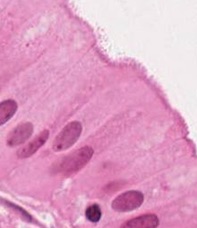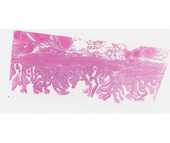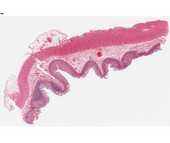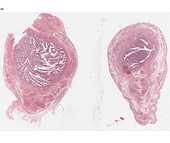Cells, Organelles: Polarity & Cellular Specializations
Epithelial Cells in Glands
In the diagram below identify the base and apex of the cells of a secretory unit, the acinus or gland. Note the basophilia in the basal compartment and the acidophilia in the apical (luminal) compartment of the cytoplasm. What subcellular organelle is responsible for attracting the basic stain?
#115 Gall bladder H&E - Microvilli
 Examine the cells lining the lumen of this organ, the gall bladder. The apical border of these cells faces the lumen. A border may be identified at the apex of the cells which has slightly different optical properties from the remainder of the cell. Under optimum conditions faint striations, oriented parallel to the long axis of the cell, are seen in the border. These are difficult to resolve at the light microscopic level, but with electron microscopy, these striations are seen to be precisely arranged microvilli, containing cores of actin filaments. Why are the microvilli not visible on all cells lining the lumen?
Examine the cells lining the lumen of this organ, the gall bladder. The apical border of these cells faces the lumen. A border may be identified at the apex of the cells which has slightly different optical properties from the remainder of the cell. Under optimum conditions faint striations, oriented parallel to the long axis of the cell, are seen in the border. These are difficult to resolve at the light microscopic level, but with electron microscopy, these striations are seen to be precisely arranged microvilli, containing cores of actin filaments. Why are the microvilli not visible on all cells lining the lumen?
#117 Small intestine H&E - Microvilli
Study the cells lining the lumen of the small intestine as another example of a microvillous border. The lining cells of the small intestine will be studied in more detail at a later time.
#68 Uterine, Fallopian tube H&E -- Cilia and basal bodies
Locate the cells lining the lumen of the oviduct. Using the 20-40X, study the free surface of the cells. The majority have fine, hair-like projections called cilia. At the apex of these cells note the pink line, which indicates the presence of the basal bodies that give rise to the cilia. Consult electron micrographs for the content and morphology of cilia and their basal bodies. There are also secretory cells along this epithelium. These have elongated nuclei and sometimes project above the epithelial surface.


